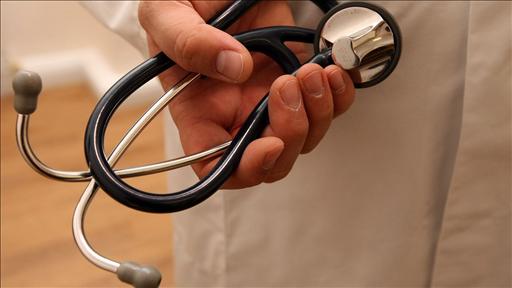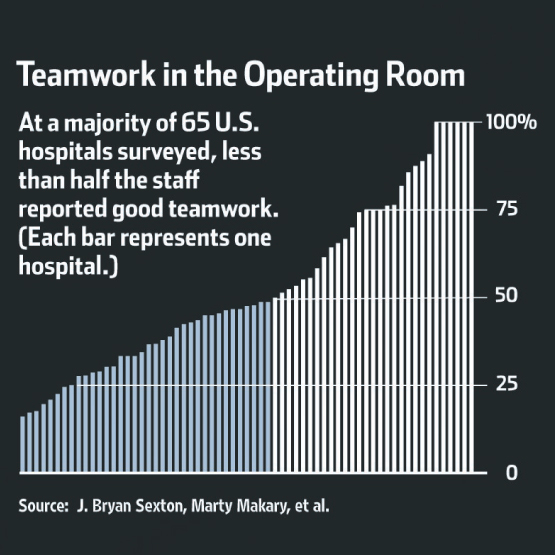How to Stop Hospitals From Killing Us
Medical errors kill enough people to fill four jumbo jets a week. A surgeon with five simple ways to make health care safer.
When there is a plane crash in the U.S., even a minor one, it makes headlines. There is a thorough federal investigation, and the tragedy often yields important lessons for the aviation industry. Pilots and airlines thus learn how to do their jobs more safely.
The world of American medicine is far deadlier: Medical mistakes kill enough people each week to fill four jumbo jets. But these mistakes go largely unnoticed by the world at large, and the medical community rarely learns from them. The same preventable mistakes are made over and over again, and patients are left in the dark about which hospitals have significantly better (or worse) safety records than their peers.

WSJ’s Gary Rosen talks to author and surgeon Marty Makary about his ideas for making American hospitals more transparent about their safety records and more accountable for the quality of their care.
As doctors, we swear to do no harm. But on the job we soon absorb another unspoken rule: to overlook the mistakes of our colleagues. The problem is vast. U.S. surgeons operate on the wrong body part as often as 40 times a week. Roughly a quarter of all hospitalized patients will be harmed by a medical error of some kind. If medical errors were a disease, they would be the sixth leading cause of death in America—just behind accidents and ahead of Alzheimer’s. The human toll aside, medical errors cost the U.S. health-care system tens of billions a year. Some 20% to 30% of all medications, tests and procedures are unnecessary, according to research done by medical specialists, surveying their own fields. What other industry misses the mark this often?
It does not have to be this way. A new generation of doctors and patients is trying to achieve greater transparency in the health-care system, and new technology makes it more achievable than ever before.
I encountered the disturbing closed-door culture of American medicine on my very first day as a student at one of Harvard Medical School’s prestigious affiliated teaching hospitals. Wearing a new white medical coat that was still creased from its packaging, I walked the halls marveling at the portraits of doctors past and present. On rounds that day, members of my resident team repeatedly referred to one well-known surgeon as “Dr. Hodad.” I hadn’t heard of a surgeon by that name. Finally, I inquired. “Hodad,” it turned out, was a nickname. A fellow student whispered: “It stands for Hands of Death and Destruction.”
Stunned, I soon saw just how scary the works of his hands were. His operating skills were hasty and slipshod, and his patients frequently suffered complications. This was a man who simply should not have been allowed to touch patients. But his bedside manner was impeccable (in fact, I try to emulate it to this day). He was charming. Celebrities requested him for operations. His patients worshiped him. When faced with excessive surgery time and extended hospitalizations, they just chalked up their misfortunes to fate.
Dr. Hodad’s popularity was no aberration. As I rotated through other hospitals during my training, I learned that many hospitals have a “Dr. Hodad” somewhere on staff (sometimes more than one). In a business where reputation is everything, doctors who call out other doctors can be targeted. I’ve seen whistleblowing doctors suddenly assigned to more emergency calls, given fewer resources or simply badmouthed and discredited in retaliation. For me, I knew the ramifications if I sounded the alarm over Dr. Hodad: I’d be called into the hospital chairman’s office, a dread scenario if I ever wanted a job. So, as a rookie, I kept my mouth shut. Like the other trainees, I just told myself that my 120-hour weeks were about surviving to become a surgeon one day, not about fixing medicine’s culture.
Hospitals as a whole also tend to escape accountability, with excessive complication rates even at institutions that the public trusts as top-notch. Very few hospitals publish statistics on their performance, so how do patients pick one? As an informal exercise throughout my career, I’ve asked patients how they decided to come to the hospital where I was working (Georgetown, Johns Hopkins, D.C. General Hospital, Harvard and others). Among their answers: “Because you’re close to home”; “You guys treated my dad when he died”; “I figured it must be good because you have a helicopter.” You wouldn’t believe the number of patients who have told me that the deciding factor for them was parking.
There is no reason for patients to remain in the dark like this. Change can start with five relatively simple—but crucial—reforms.
Online Dashboards
Every hospital should have an online informational “dashboard” that includes its rates for infection, readmission (what we call “bounce back”), surgical complications and “never event” errors (mistakes that should never occur, like leaving a surgical sponge inside a patient). The dashboard should also list the hospital’s annual volume for each type of surgery that it performs (including the percentage done in a minimally invasive way) and patient satisfaction scores.
Nothing makes hospitals shape up more quickly than this kind of public reporting. In 1989, the first year that New York’s hospitals were required to report heart-surgery death rates, the death rate by hospital ranged from 1% to 18%—a huge gap. Consumers were finally armed with useful data. They could ask: “Why have a coronary artery bypass graft operation at a place where you have a 1-in-6 chance of dying compared with a hospital with a 1-in-100 chance of dying?”
Instantly, New York heart hospitals with high mortality rates scrambled to improve; death rates declined by 83% in six years. Management at these hospitals finally asked staff what they had to do to make care safer. At some hospitals, the surgeons said they needed anesthesiologists who specialized in heart surgery; at others, nurse practitioners were brought in. At one hospital, the staff reported that a particular surgeon simply wasn’t fit to be operating. His mortality rate was so high that it was skewing the hospital’s average. Administrators ordered him to stop doing heart surgery. Goodbye, Dr. Hodad.
Safety Culture Scores
Imagine that a surgeon is about to make an incision to remove fluid from a patient’s right lung. Suddenly, a nurse breaks the silence. “Wait. Are we doing the right or the left chest? Because it says here left, but that looks like the right side.” The surgery was, indeed, supposed to be on the left lung, but an intern had prepped the wrong side. I was that doctor, and that nurse saved us all from making a terrible error. It isn’t every hospital where that nurse would have felt confident speaking up—but it’s this sort of cultural factor that is so important to safety.
If anyone knows whether a hospital is safe, it’s the people who work there. So my colleagues and I at Johns Hopkins, led by J. Bryan Sexton, administered an anonymous survey of doctors, nurses, technicians and other employees at 60 U.S. hospitals. We found that at one-third of them, most employees believed the teamwork was bad. These aren’t hospitals where you or I want to receive care or see our family members receive care. At other hospitals, by contrast, an impressive 99% of the staff reported good teamwork.
These results correlated strongly with infection rates and patient outcomes. Good teamwork meant safer care. The public needs to have access to such information for every hospital in America.
Cameras
It may come as a surprise to patients, but doctors aren’t very good at complying with well-established best practices in their fields. One New England Journal of Medicine study found that only half of all care follows evidence-based guidelines when applicable. Fortunately, there is a technology that could work wonders to improve compliance: cameras.

CorbisYou wouldn’t believe the number of patients who have told me their deciding factor in choosing a hospital was parking.
Cameras are already being used in health care, but usually no video is made. Reviewing tapes of cardiac catheterizations, arthroscopic surgery and other procedures could be used for peer-based quality improvement. Video would also serve as a more substantive record for future doctors. The notes in a patient’s chart are often short, and they can’t capture a procedure the way a video can.
Doug Rex of Indiana University—one of the most respected gastroenterologists in the world—decided to use video recording to check the thoroughness of colonoscopies being performed by doctors in his practice. A thorough colonoscopy requires meticulous scrutiny of every nook and cranny of the colon. Doctors tend to rush through them; as a result, many cancers and precancerous polyps are missed and manifest years later—at later stages.
Without telling his partners, Dr. Rex began reviewing videotapes of their procedures, measuring the time and assigning a quality score. After assessing 100 procedures, he announced to his partners that he would be timing and scoring the videos of their future procedures (even though he had already been doing this). Overnight, things changed radically. The average length of the procedures increased by 50%, and the quality scores by 30%. The doctors performed better when they knew someone was checking their work.
Following Dr. Rex’s camera study, he did a follow-up, asking patients if they would like a copy of their procedure video. An overwhelming 81% said yes, and 64% were willing to pay for it. Patients are hungry for transparency.
Open Notes
Sue, a young accountant, came to my office complaining of abdominal pain. She wasn’t sure what was causing it. She offered various theories: “Could this be from my Bikram yoga?” “Did my late-night ice cream cause the pain?” “Does having unprotected sex have anything to do with it?” Throughout her visit, I took notes. When we were done, she looked down at them suspiciously.

“What did you write about me?” she asked.
She was concerned that I thought she was either nuts or an ice-cream addict. In the course of our conversation, I also learned that she wasn’t quite sure why I was recommending an ultrasound, though I thought I had told her.
I decided to start dictating my notes with the patient listening in at the end of his or her visit. “I also have high blood pressure,” was a correction one older patient blurted out. Another said, “My prior surgery was actually on the right, not the left side.” Another patient interrupted me and said, “No, I said I take 20 milligrams, not 25 milligrams, of Lipitor.” Being able to review your doctor’s notes in writing might be even better than my method, particularly if you could add your own comments, perhaps via the Web.
Harvard doctor-researchers Jan Walker and Tom Delbanco are using “open notes” at Harvard and Beth Israel Hospital in Boston, and my hometown hospital, Geisinger Medical Center in Pennsylvania, has begun giving patients online access to their doctors’ notes. So far, both patients and doctors love it.
No More Gagging
Though there are many signs that health care is moving toward increased transparency, there is also some movement backward. Increasingly, patients checking in to see doctors are being asked to sign a gag order, promising never to say anything negative about their physician online or elsewhere. In addition, if you are the victim of a medical mistake, hospital lawyers will make never speaking publicly about your injury a condition of any settlement.
We need more open dialogue about medical mistakes, not less. It wouldn’t be going too far to suggest that these types of gag orders should be banned by law. They are utterly contrary to a patient’s right to know and to the concept of learning from our errors.
Political partisans can debate the role of government in fixing health care, but for either public or private approaches to work, transparency is the crucial prerequisite. To make transparency effective, government must play a role in making fair and accurate reports available to the public. In doing so, it will unleash the power of the free market as patients are better able to take charge of their own care. When hospitals have to compete on measures of safety, all of them will improve how they serve their patients.
Transparency can also help to restore the public’s trust. Many Americans feel that medicine has become an increasingly secretive, even arrogant, industry. With more transparency—and the accountability that it brings—we can address the cost crisis, deliver safer care and improve how we are seen by the communities we serve. To do no harm going forward, we must be able to learn from the harm we have already done.
By Dr. Marty Makary, from: http://online.wsj.com/article/SB10000872396390444620104578008263334441352.html
photo credit: Leonard Mccombe/Time Life Pictures/Getty Images; Photo Illustration/The Wall Street Journal
Dr. Makary, a surgeon at Johns Hopkins Hospital and a developer of the surgical checklists adopted by the World Health Organization, is the author of “Unaccountable: What Hospitals Won’t Tell You and How Transparency Can Revolutionize Health Care,” published this month by Bloomsbury Press.









